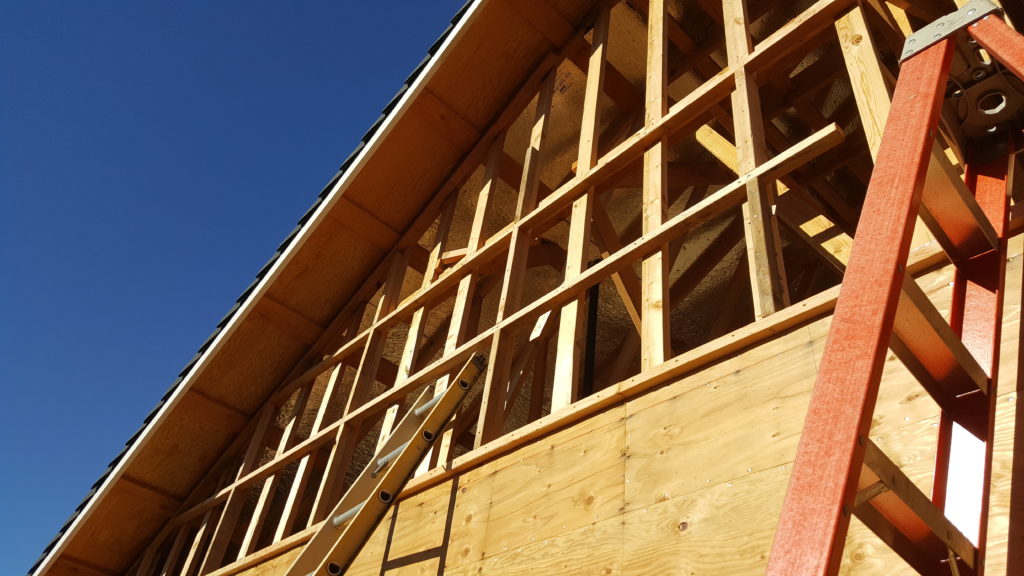How to Apply Continuous Plywood Sheathing Efficiently

 Installing continuous plywood sheathing isn’t one of the more difficult tasks in building a house, but my mentor showed me how to do it the right way. The first step is to nail in blocking between the studs at the sections where the plywood sheets will break. The perimeter of every single sheet must be nailed down in order to satisfy code requirements. It is a lot of work to cut blocks to fit in between all of the studs but once they are nailed in it gives a really nice, clean look to the wall. The best practice is to end nail one side of the block and toe nail the other side (you can’t end nail the other side because the previous block is in the way). As you can see, the blocks obviously don’t need to be applied inside the window rough openings.
Installing continuous plywood sheathing isn’t one of the more difficult tasks in building a house, but my mentor showed me how to do it the right way. The first step is to nail in blocking between the studs at the sections where the plywood sheets will break. The perimeter of every single sheet must be nailed down in order to satisfy code requirements. It is a lot of work to cut blocks to fit in between all of the studs but once they are nailed in it gives a really nice, clean look to the wall. The best practice is to end nail one side of the block and toe nail the other side (you can’t end nail the other side because the previous block is in the way). As you can see, the blocks obviously don’t need to be applied inside the window rough openings.
Once the blocks are all nailed in, it’s vital to apply a layer of caulk to the outer studs, top and bottom plates, as well as all window and door openings. This will create an air barrier at the exterior walls and decrease the opportunity for leakage. The sheets are installed in just the same fashion as the foil faced roof sheathing (minus the H-clips). Place the panel so that there is room for nailing on all four sides, and then hammer down 8d nails 6 inches apart on the edges and 12 inches apart in the field wherever a stud lies. When hammering in the nails on the edge, the best practice is to stagger them every 3 inches so they look as if they have been sewn together. One of the advanced framing techniques used on my design is to use wall lengths divisible by 4 feet. This ensures that the studs will line up with the trusses every 2 feet, but also saves costs on sheathing because the plywood comes in 4ft by 8ft sheets. The next layer of sheets should be staggered so that the sheets meet above the center (or as close as possible) of the sheet below it. Ideally this would mean beginning with a full size 8 foot sheet on the first layer and then starting the next layer with a 4 foot sheet. Window and door openings can be cut either before or after nailing down the sheet. When the door or window opening falls on the end of a sheet, cut out the opening before nailing. When the opening falls in the middle of a sheet, cut it out after, using a drill to put a hole in each corner, a straight edge to connect the holes, and then a circular saw or jigsaw to cut out the opening on the lines.
I learned about a great idea to reduce costs by cutting out the foam insulation on the gable end walls outside the attic. On my design, the exterior plywood is covered with a 2 inch layer of polyisocyanurate foam to help insulate the walls. The attic, on the other hand, has no need for this extra insulation. To maintain the same thickness of the wall on the gable ends, I will use 2 inch strips of wood to fur the plywood (you can see them jutting out above the plywood in the pic to the left) I will place these strips wherever the edge of a sheet will end up. After the furring strips are nailed in, the plywood will be fastened just the same as before, but the end pieces will be cut to follow the slope of the gable end truss. Here’s an example…


Greetings! Very useful advice within this article! It’s
the little changes which will make the greatest changes.
Thanks a lot for sharing!